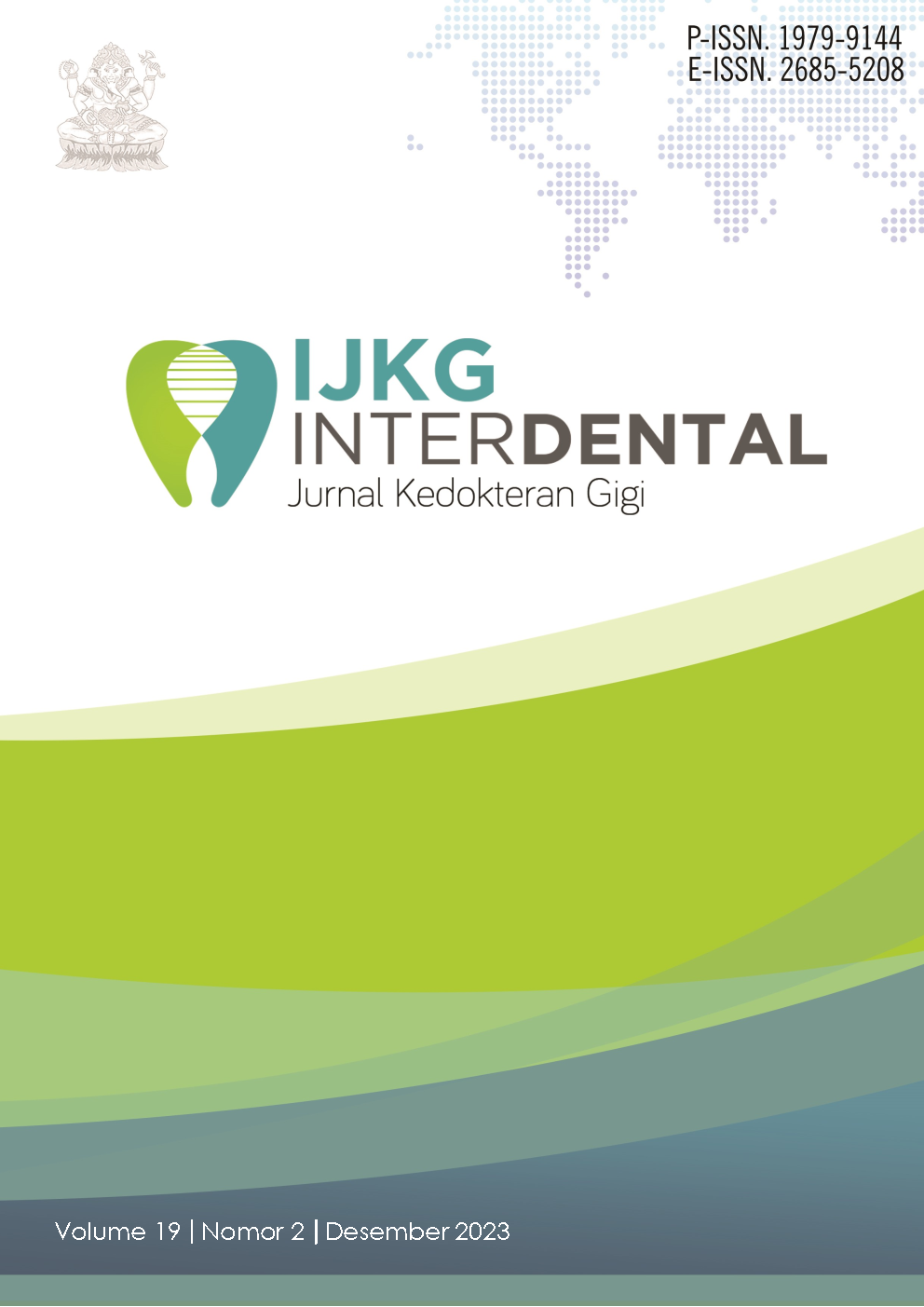ACUTE TOXICITY TEST OF AMBON BANANA TREE SAP EXTRACT ON MICE (Mus Muculus L.)
DOI:
https://doi.org/10.46862/interdental.v19i2.7480Keywords:
Acute and allergic toxicity tests, Ambon banana tree sap extractAbstract
Introduction: Banana tree sap is commonly used by the community as herbal medicine in the process of accelerating wound healing so it needs to be tested for the safety of its use. The research entitled Test of Acute Toxicity and Allergy of Ambon Banana Tree Sap Extract to Mice (Mus Muculus L.) aims to determine Lethal Dose 50, toxicity classification and to observe allergic symptoms dermally of Ambon banana tree sap extract to mice.
Materials and Methods: In the acute toxicity test using the Thomson Weil calculation method using mice as experimental animals as many as 25 which were divided into 5 treatment groups with the main test series group I as the control group with 0.3% Na-CMC, groups 2-5 were given the test extract with doses of 300, 600, 1200 and 2400mg/kgBW with one oral administration and observed the number of deaths in each test animal for 14 days.
Results and Discussions: In allergy testing using the Wilocoxon method. From the results of the acute toxicity test study, the LD50 value of banana tree sap extract was 1116.8mg/kgBW (1.116g/kgBW) included in the moderate toxic category (0.5-5g/kgBW) and in the allergy test it did not cause allergies (no rash and red-red). For acute toxicity, the weights of mice were analyzed using the ANOVA and LSD tests as well as the allergy test using Wilocoxon. The results of the analysis show that there is a significant difference at the test level of 0.05 (???? <0.05). in the allergy test obtained statistical test results which stated that there was no allergic reaction in mice during treatment with a ???? value of 1.000 > 0.05.
Conclusion: Giving banana tree sap extract at certain doses can cause death in mice but does not cause any allergic symptoms.
Downloads
References
Purwaningsih, Budiarti S.W dan Suwarti., Kontaminasi Fungi Aspergillus Sp. Pada Biji Jagung Ditempat Penyimpanan Dengan Kadar Air Yang Berbeda., Balai Pengkajian Teknologi Pertanian Yogyakarta, Balai Penelitian Tanaman Serealia. 2015.
Hafizha, Suardita K, Pribadi N., Daya Antibakteri Ekstrak Batang Pisang Ambon (Musa paradisiaca var. sapientum) terhadap Pertumbuhan Enterococcus faecalis. Conservative Dentistry Journal. 2018, Vol.8 No.2, p. 85-90.
Elin YS., Qowiyah A., Purnamasari R., Teratogenicity study of combination of ginger rhizome extract and noni fruit extract in Wistar rat, Indonesian Journal of Pharmacy, 2009, Vol 20, No 1.
Nugroho RA dkk., Acute and Subchronic Toxicity Study of the Ethanol Extracts from, Ficus deltoidea Leaves in Male Mice, Macedonian Journal of Medical Sciences. 2020, Vol.15. No 8, p.76-83.
Amutha K., Selvakumari U., Wound healing activity of methanolic stem extract of Musa paradisiaca Linn. (Banana) in Wistar albino rats, International Wound Journal, 2014, p.763-767.
Apriasari ML dkk., The effect of 25% Mauli banana stem extract gel to increase the epithel thickness of wound healing process in oral mucosa, Dental Journal (Majalah Kedokteran Gigi), 2015, Vol. 48, No.3, p.151–154.
Mansur. 2008. Toksikologi dan Distribusi Agent Toksik. Edisi ke−2. Jakarta: UI Press.
Ambarita M., Bayu E., Setiado H., Identifikasi Karakter Morfologis Pisang (Musa spp.) di Kabupaten Deli Serdang, Jurnal Agroteknologi, 2015, Vol. 4, No 1.
Donatus, I.A. Toksikologi Dasar, Laboratorium Farmakologi dan Toksikologi, Fakultas Farmasi, UGM, Yogyakarta, 2005.
OECD (Organization for Economic Cooperation and Development), 2008. https://ntp.niehs.nih.gov/iccvam/suppdocs/feddocs/oecd/oecdtg425.pdfdiakses pada tanggal 15 Januari 2022.
Budi H., Arundina I., Indrawati R., Mahardikasari L., Uji toksisitas akut ekstrak batang pisang ambon (Musa paradisiaca var sapientum) terhadap hati mencit (Mus musculus) dengan parameter LD50, Dentofasial J, 2014, Vol.13, No.2, p:86-90.
Rosanto Y., Handajani J., Susilowati H., Efek Pemberian Gel Getah Batang Tanaman Pisang Secara Topikal terhadap Kepadatan Serabut Kolagen Pada Proses Penyembuhan Luka Pasca Ekstraksi Gigi Marmut, Dentika Dental Jurnal, 2012, Vol. 17, No 1.
Khairunnisa S., Ningtyas A., Haykal S., SariM, Efektivitas getah pohon pisang (Musa Paradisiaca) pada Penyembuhan Luka Soket Pasca Pencabutan Gigi, J Ked Gi Unpad, 2018, Vol. 30, No 2.
Wakkary, J.J., Dury M., Kairupan C., Pengaruh Pemberian Getah Bonggol Pisang (Musa paradisiaca var. sapietum L. Kuntze. AAB) Terhadap Penyembuhan Luka Sayat pada Kulit Tikus (Rattus norvegicus). Jurnal e-Biomedik (eBm), 2017, Vol. 5, No.1.
Downloads
Published
How to Cite
Issue
Section
License
Copyright (c) 2023 Setiawan, Hendri Poernomo, Reza Pramana

This work is licensed under a Creative Commons Attribution-ShareAlike 4.0 International License.
- Every manuscript submitted to must observe the policy and terms set by the Interdental Jurnal Kedokteran Gigi (IJKG)
- Publication rights to manuscript content published by the Interdental Jurnal Kedokteran Gigi (IJKG) is owned by the journal with the consent and approval of the author(s) concerned.
- Full texts of electronically published manuscripts can be accessed free of charge and used according to the license shown below.













